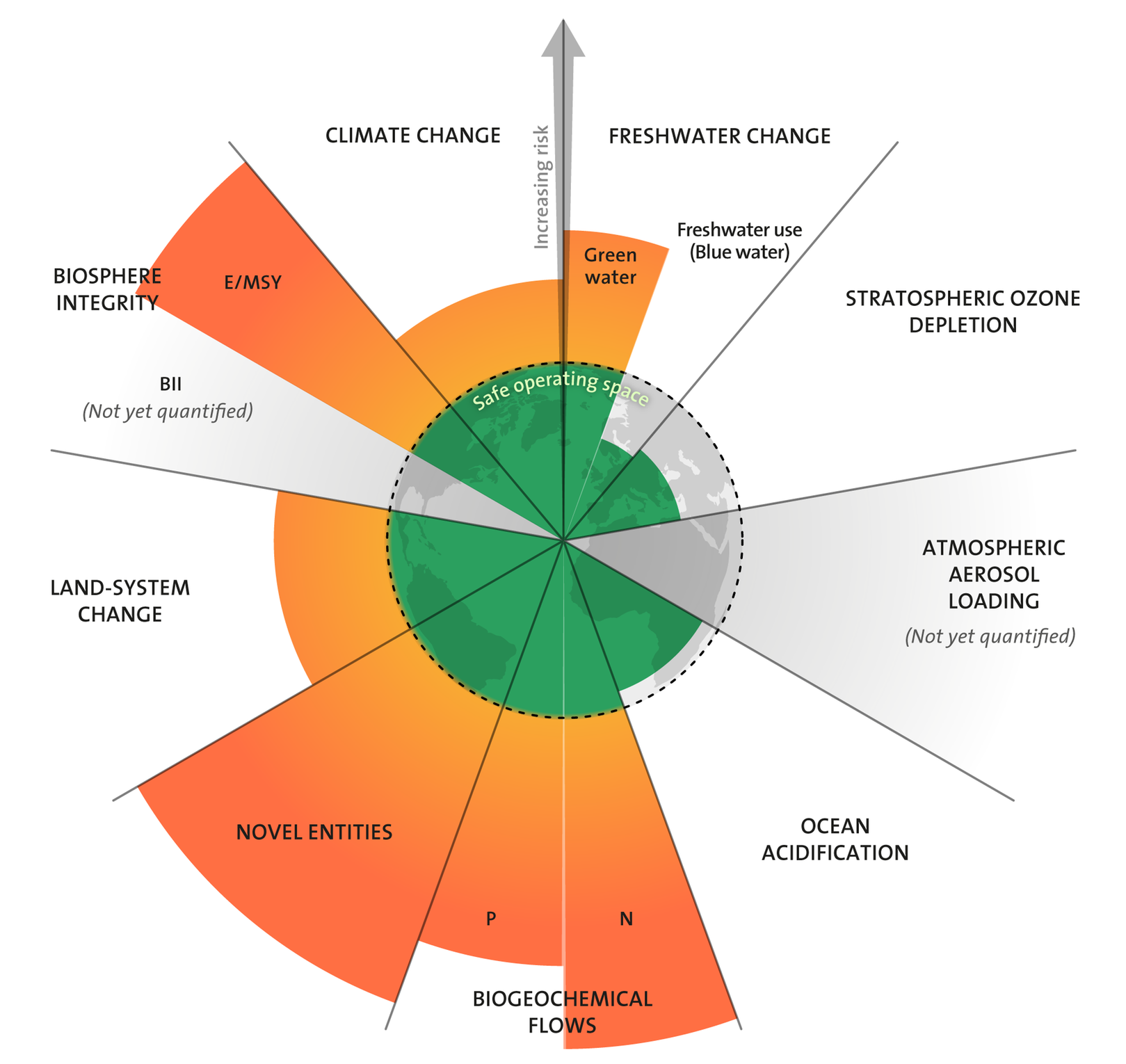Hi everyone,
So today we're talking about a model that was introduced in 2009 and has offered a new perspective to thinking about environmental issues.
So today we're talking about a model that was introduced in 2009 and has offered a new perspective to thinking about environmental issues.
The planetary boundary model has 9 boundaries, each has a safe zone. Once the
safe zone is exceeded, the stable conditions on our planet are considered at
risk, and there can be severe and possibly irreversible changes. The nine
boundaries are considered separate however, they greatly affect each
other.
Novel Entities describes the introduction and accumulation of man-made
novel chemical compounds. These include pesticides, nuclear waste and
microplastics.
Stratospheric Ozone Depletion refers to the depletion of the ozone
layer which was a major problem in the 90s.
Atmospheric Aerosol Loading is air particle pollution.
Ocean Acidification is self-explanatory.
The boundary Biochemical Flows is composed of two separate boundaries;
nitrogen and phosphorus. Both of the elements are vital for plant growth. They
are therefore removed from the atmosphere/soil and turned into fertilisers
which normally just wash away in the rain and pollute nearby waterways.
Freshwater Use is also split into two separate boundaries. The first is
green water, which describes all water absorbed in soils, crops, plants and
forests. This is sometimes called invisible water. The second is blue water,
which describes water in rivers, lakes and streams, often known as visible
water.
The process of turning natural habitats such as rainforests and grasslands
into agricultural land is known as Land-System Change.
The two boundaries that make up Biosphere Integrity are functional and
genetic.
The last boundary is probably the best known; Climate Change. Here
there are two boundaries, CO2 levels and radiative forcing.
When introduced in 2009, biosphere integrity (at this point only one goal), climate change (also only one goal) and the nitrogen part of biochemical flows were already exceeded. Novel entities and atmospheric aerosol loading were not yet accessed.
In 2015, biosphere integrity was split into two boundries and land-system change and the phosphorus part of biochemical flows also left the safe zone. Novel entities and atmospheric aerosol loading still weren't accessed.
This year, 2023, all 9 boundaries were assessed for the first time. Climate change has been split into its separate boundaries, ocean acidification is worryingly close to leaving the safe zone. Both boundaries of freshwater use and novel entities have left the safe zone.
The only boundary which has got better is stratospheric ozone depletion. If this model had existed in the 1990s then the ozone depletion would have been out of the safe area. But regulations and initiatives have lead this boundary to now be the furthest from leaving its safe zone than all the rest.
One of the best things about this model is that it shows that the environmental crisis is so much more than just climate change. It shows how in every aspects, there is work to do and with the example of ozone depletion also shows that we can make a difference. We hope you enjoyed this post.
Your Green World Blog Team💚
Sources:
https://www.science.org/doi/10.1126/science.1259855
https://www.stockholmresilience.org/research/research-news/2023-09-13-all-planetary-boundaries-mapped-out-for-the-first-time-six-of-nine-crossed.html
https://planetaryinternational.com/2021/07/lets-discuss-the-9-planetary-boundaries/
https://www.stockholmresilience.org/research/planetary-boundaries.html
Image:
Designed by Azote for Stockholm Resilience Centre, CC BY-SA 3.0, via Wikimedia Commons
https://www.science.org/doi/10.1126/science.1259855
https://www.stockholmresilience.org/research/research-news/2023-09-13-all-planetary-boundaries-mapped-out-for-the-first-time-six-of-nine-crossed.html
https://planetaryinternational.com/2021/07/lets-discuss-the-9-planetary-boundaries/
https://www.stockholmresilience.org/research/planetary-boundaries.html
Image:
Designed by Azote for Stockholm Resilience Centre, CC BY-SA 3.0, via Wikimedia Commons



Comments
Post a Comment